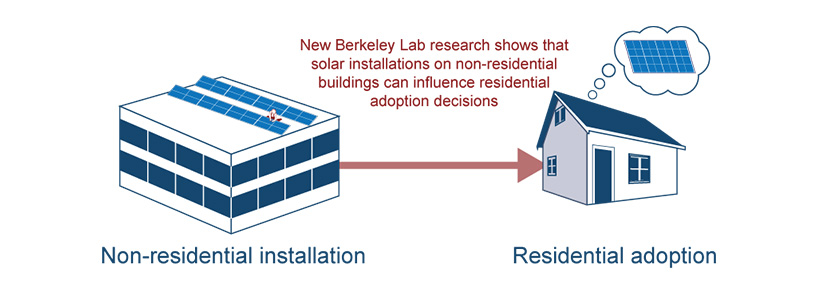Commercial-Scale Solar PV Increases Local Residential Solar Adoption
Feb. 28, 2024 by Isa Ferrall-Wolf and Kamyria Coney
The third round of the Solar Energy Innovation Network explored new approaches to the equitable adoption of solar energy through teams of stakeholders with two cohorts focused on residential and commercial building topics. As the Round 3 teams continued their place-based research and development, researchers at Lawrence Berkeley National Laboratory (LBNL) and NREL dove into national-scale data to understand solar adoption behaviors and decision-making between the two cohorts of solar adopter applications.
Previous research has established a peer effect across residential solar adoptions, where past residential PV adoptions exert a social influence to increase future local residential PV adoptions, i.e., if your neighbor installs solar, you may be more likely to do so on your house. LBNL and NREL researchers expanded this notion to explore if nonresidential PV installations (such as those pursued by the SEIN Round 3 Commercial-scale cohort) influence local residential PV adoptions (such as those pursued by the SEIN Round 3 Residential-scale cohort). And if so, by how much.
In an open-access journal article titled Impacts of Nonresidential Solar on Residential Adoption Decisions published in Frontiers in Sustainable Energy Policy, they did just that with some fancy statistics.

The researchers applied a staggered differences-in-differences statistical methodology to nonresidential and residential solar adoptions recorded in LBNL's Tracking the Sun dataset to estimate influence effects. They found a quantifiable and persistent increase in residential solar adoptions in proximity to nonresidential solar installations. For instance, for each nonresidential installation, there is on the order of 0.4 additional residential adoptions per calendar quarter into the future.
The study then examined if the type of nonresidential building (commercial, government, schools, or houses of worship) changed the amount of influence on local residential adoptions. In this calculation, nonresidential installations on commercial and government buildings had statistically significant and larger average treatment effects, while schools and houses of worship had smaller treatment effects that were not statistically significant. However, the sample sizes differed greatly across the four types, likely influencing the above result. When the average treatment effect for each nonresidential building type was divided by the number of installations of that type, the interpretation of the data changed, i.e., "Each commercial install influences around 0.06 [residential] installs per quarter, each government and school install influences around 0.3 installs per quarter, and each house-of-worship install influences around 1.2 installs per quarter."
This study suggests that nonresidential solar installations can serve as partners in policies to "seed" local residential adoption and that the two SEIN cohorts (commercial-scale and residential-scale) may have more in common than previously thought. Examining the impact along social linkages (such as among members of a house of worship) is an area for future research. Be sure to check out LBNL's webinar to find out more about this research from LBNL and NREL staff as well as SEIN's Round 3 team project led by RE-Volv.
Interested in learning more about SEIN? Subscribe to our mailing list.
Share
